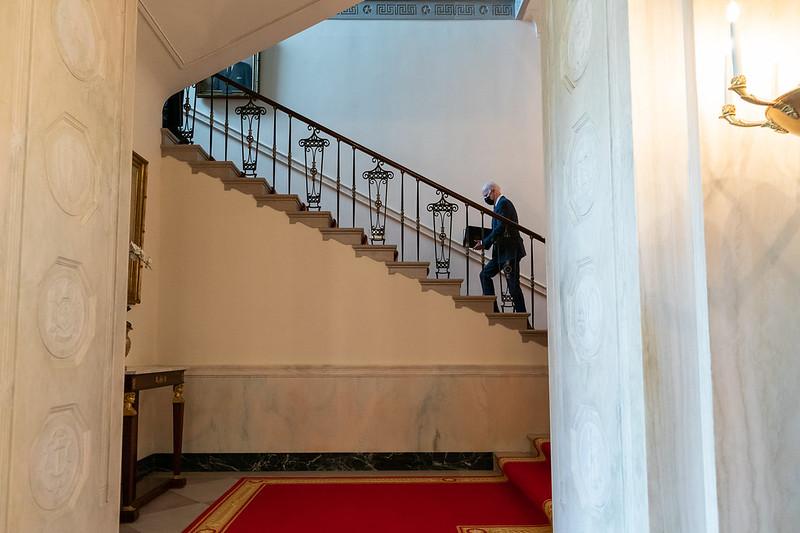
Joe Biden has been president of the United States for 100 days, less than 7% of the time he was elected to serve. Still, it’s not too soon to draw some tentative conclusions about the nature of his presidency.
Biden’s principal accomplishment to date is the expansion of the Covid-19 vaccine supply and the acceleration of domestic immunisation against the disease. Some 220 million doses have been administered in the US since Biden took office. There is more than enough supply to ensure that every adult can be vaccinated. The daily death toll from the disease has fallen from over 4,000 per day to well under 1,000. The economy is poised to take off, with some even worrying that it could overheat.
In these same 100 days, the basic themes of the Biden presidency, articulated in his 28 April address to Congress, have emerged: an emphasis on tackling domestic challenges, a vastly expanded role for the federal government in both stimulating the economy and in providing basic services and financial support for citizens, and a commitment to confront racism, modernise infrastructure, increase the country’s competitiveness, and combat climate change. There’s also a willingness to raise taxes on corporations and the wealthy to pay for some of what these initiatives will cost. How much of this agenda can be realised remains to be seen; for now, comparisons between Biden and Franklin Roosevelt or Lyndon Johnson are understandable but somewhat premature.
Much of what Biden has done or wants to do represents a sharp departure from his predecessor, Donald Trump, and is popular with many Americans. On immigration, however, Biden’s approach is proving otherwise. His messaging is seen by some as partly responsible for the surge in people trying to enter the US via its southern border. Meanwhile, ceilings on refugee admissions are too high for many Republicans and not high enough for many Democrats.
It’s on foreign policy, though, where the comparisons with Trump are the most interesting. At first glance, Biden could not be more different. He embraces multilateralism and has brought the US back into the World Health Organization and the Paris climate agreement. And his administration is working to reboot the 2015 nuclear deal with Iran that Trump unilaterally exited.
Biden has also restored traditional allies and alliances to a core position in US foreign policy. He has already hosted Japanese Prime Minister Yoshihide Suga in Washington and will make his first overseas trip to Europe in June for the G7 summit. No American troops will be withdrawn from Germany, something Trump had announced he would do. And the Biden administration has made human rights a centrepiece of its foreign policy, regularly criticising Russia and China, sanctioning Myanmar, and publishing a report that holds Saudi Arabia’s Crown Prince Mohammed bin Salman responsible for the murder of Saudi journalist Jamal Khashoggi.
But there is more foreign-policy continuity between Biden and Trump than first meets the eye. Take Afghanistan, where the difference between them amounts to just over four months: Trump signed a pact with the Taliban that committed the US to withdraw all its military forces by 1 May; Biden has committed to do so by 11 September. Just as important, Biden echoed Trump’s insistence that the calendar, not local conditions, would determine the timing of the US military withdrawal.
There’s considerable continuity when it comes to policy towards China as well. One no longer hears calls for regime change, but the one high-level diplomatic contact between US and Chinese officials could hardly have been less diplomatic. Meanwhile, the Biden administration has kept tariffs and export controls in place, continued to send US warships to challenge China’s claims in the South China Sea, repeated the description of Chinese actions in Xinjiang as genocide, sanctioned Chinese officials and maintained high-level contacts with Taiwan.
As for trade, what’s consistent is the lack of initiative. Missing from an otherwise robust policy towards China is any sign that the US is reconsidering its unwillingness to join Asia–Pacific regional trade groupings. Instead, there is a continued commitment to ‘buy American’ along with talk about foreign policy for the middle class, an otherwise empty slogan that suggests trade will remain a low priority given how controversial it remains with many Americans.
Even on Covid-19, the Biden presidency has embraced something of an ‘America first’ approach when it comes to sharing (or, rather, refusing to share) American-produced vaccines with the rest of the world. This is belatedly changing, with a commitment to share an untapped supply of the AstraZeneca vaccine with others. But the shift is limited and the delay has provided strategic openings to China and Russia, slowed economic recovery around the world, increased hardship and given new variants of Covid-19 more opportunity to emerge and gain traction.
In short, while Trump is no longer in the Oval Office, Trumpism still looms large. His attacks on free trade and immigration, promotion of a narrow ‘America first’ view of the world, and bias towards retrenchment are now and for the foreseeable future part of the political fabric. The country remains polarised; Congress is nearly evenly divided. This leaves Biden limited room for manoeuvre as he seeks to promote democracy, conduct diplomacy and reinvigorate global institutions.
Like all American presidents, Biden still enjoys considerable power and influence. But, as his first 100 days have shown, the one thing American presidents cannot control is the context in which they operate.